The world of pretzels is huge, and versatile.

In Germany, these knotted breads are enormously popular. And many regions have their very own traditional types.
Some are only few inches long, others can reach a diameter of up to 20 inches. While some varieties are salty, like the typical soft pretzel, many are sweet.
One very distinct type offers a delicious combination of fluffy pastry and pudding. This is known as the puddingbrezel.
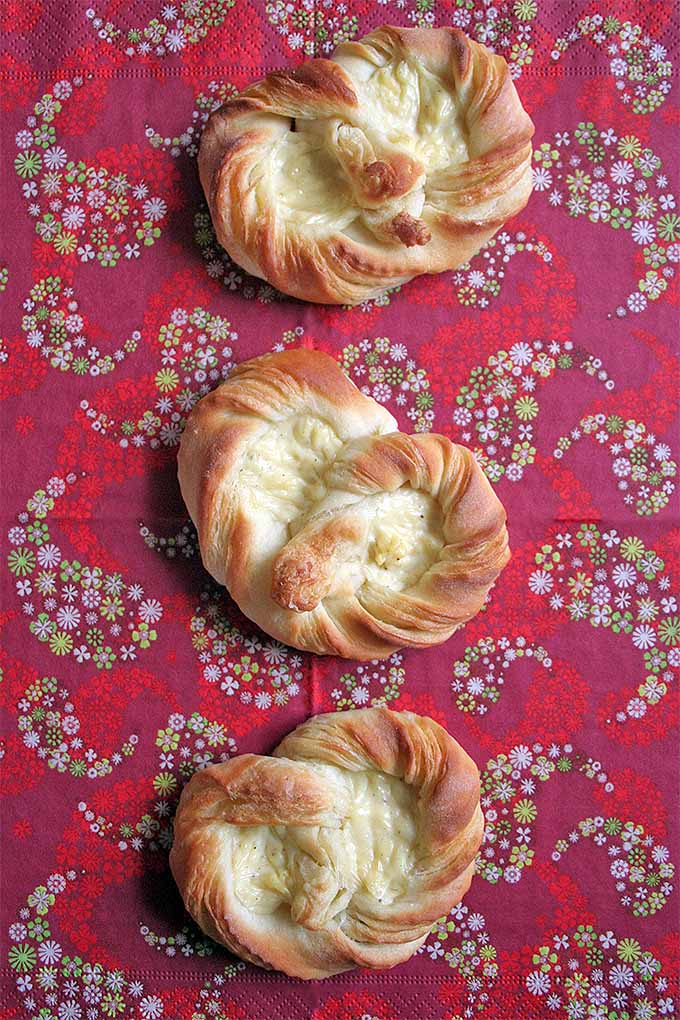
These gorgeous goodies are a bakery standard in Germany, especially in their home region of the Rhineland-Palatinate. Today, their popularity has spread all over the country.
It’s interesting to note that you will find vanilla flavored puddingbrezels exclusively in bakeries or patisseries. I have never seen a chocolate one with my own eyes.
Nonetheless, when preparing these goodies at home, feel free to use chocolate pudding if you like it better, or top with some fresh berries or other types of fruit after baking.
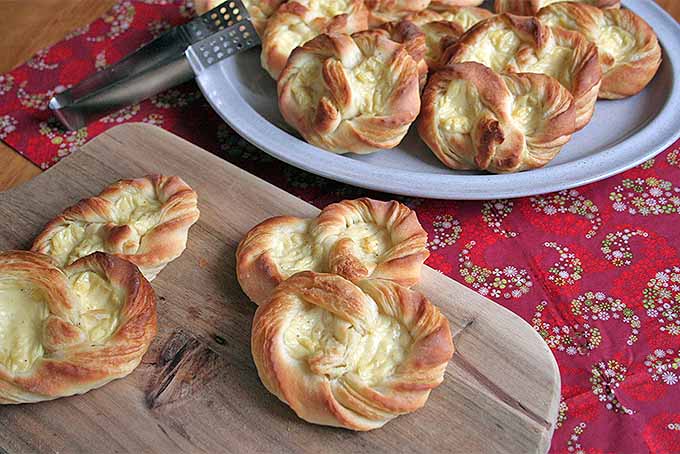
If you’ve had some practice, why not vary the shape as well? Prepare small circles or diamond shapes and fill their insides with pudding for a lovely change of pace.
In Germany, the dough for these sweet treats is called “Plunder,” which is also a term for the old stuff you usually keep in attics that you haven’t tidied up for a while.
But the pastry has nothing to do with old junk – the Old German verb “pludern” simply means rising and loosening up.
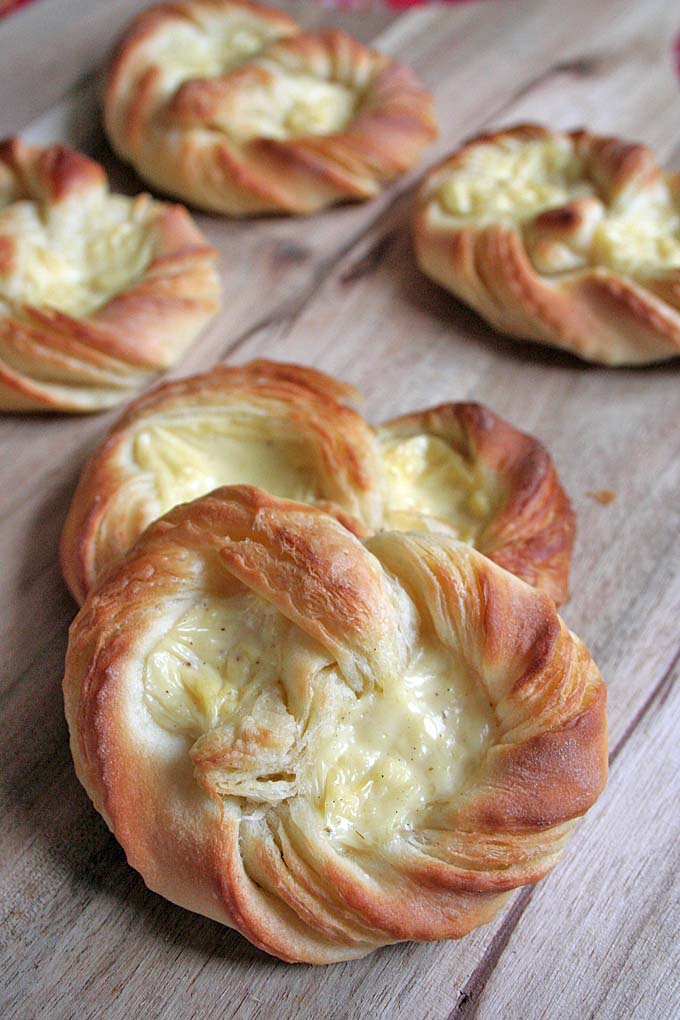
In English, danish pastries are known for being made with this type of dough as well. But what does this have to do with the Danes?
The term “danish” is connected to a strike among Danish bakers in the 19th century. When bakers from neighboring countries, especially Austria, were invited to work, they brought with them a new kind of dough, which quickly became very popular.
As soon as the strike ended, the Danish bakers started to experiment with this new dough and adapted it to their needs. And thus, the danish pastries, as we know and refer to them today, were born.
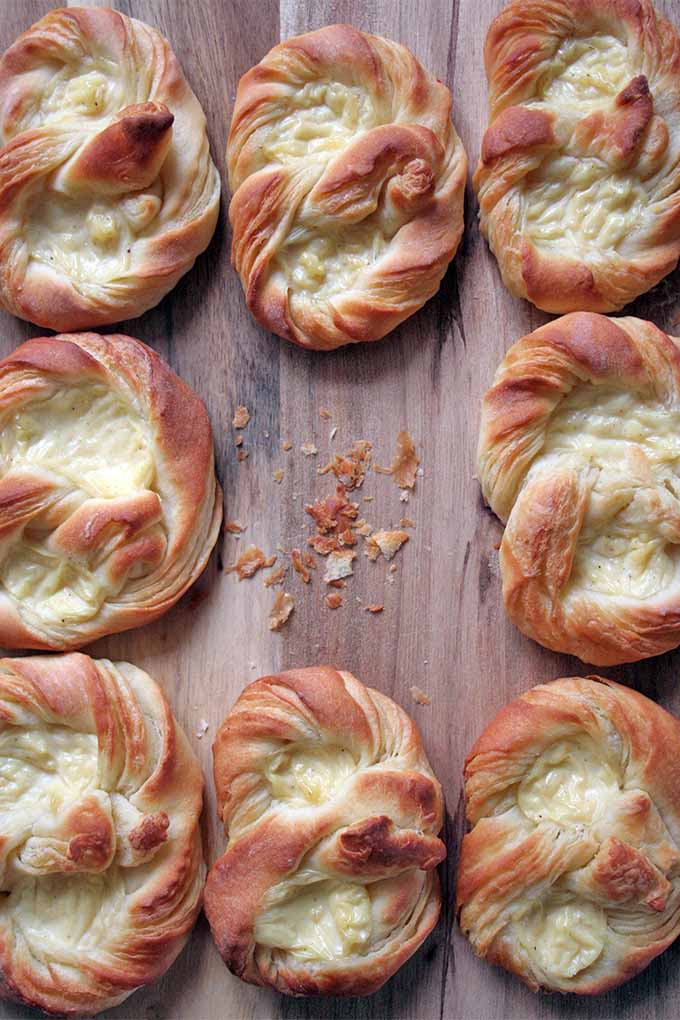
Now, this is where a bit of confusion begins, because the Scandinavians call it wienerbrød, or “Viennese bread.”
To them, the Austrians were the ones responsible for the new baking technique, so it just seemed logical to name the pastry after them.

And indeed, the special procedure that is necessary for making the breakfast pastries we know and love today is an invention of traditional Viennese patisserie. The technique the Austrians used is called lamination.
It is a variation of puff pastry, although there are certain differences.
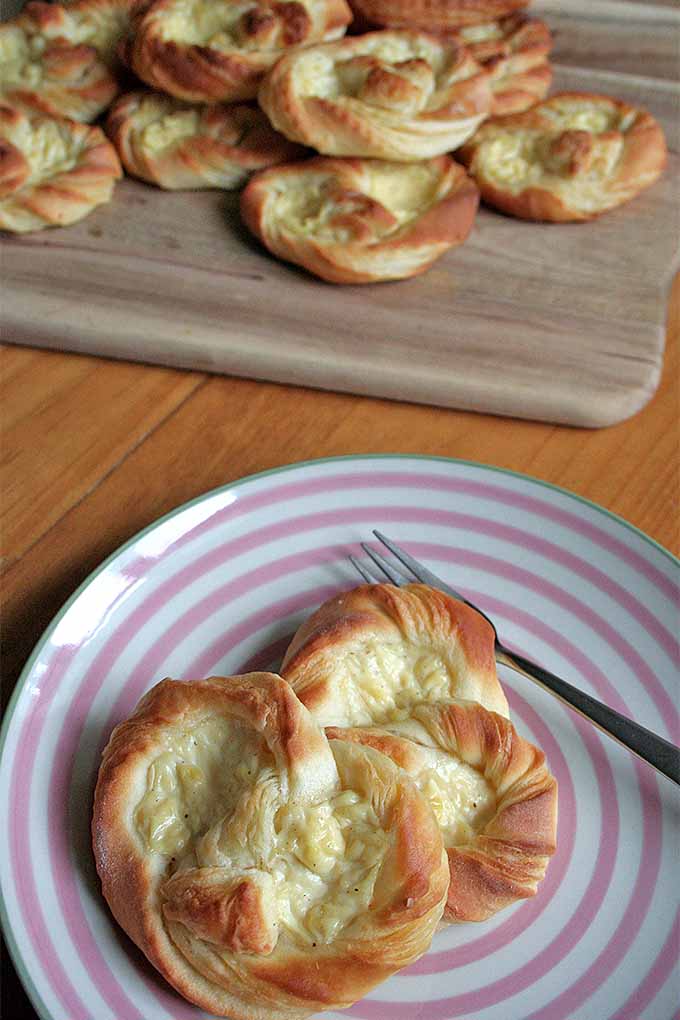
As you probably know, yeast actually needs warmth to rise and work its magic, but for this we turn the usual method upside down:
Although this dough is prepared with yeast, it is processed with cold ingredients. Then, after kneading, it is folded and rolled out again multiple times – a procedure called lamination – to achieve the desired fluffy and flaky structure.
For a successful Danish pastry, fat is needed. It works to separate the various layers of the dough as they bake, providing that light and flaky texture.
Without waiting around any longer, let’s get on with the recipe!
Print
German Puddingbrezel
- Total Time: 55 minutes
- Yield: 15 pretzels 1x
Description
A buttery Danish filled with sweet vanilla pudding, the puddingbrezel is one of a kind. Learn how to make this pretzel-shaped pastry.
Ingredients
For the filling:
For the pastry:
- 9 oz all purpose flour
- 1 oz fresh yeast
- 1/2 cup cold milk
- 1 tablespoon sugar
- 1 egg*
- 4 oz softened butter
Instructions
- Prepare the pudding, cover with plastic wrap to keep a skin from forming, and chill in the refrigerator.
- Dissolve the yeast in the milk.
- Pile the flour in a mound in a large bowl or on a floured countertop. Create a well in the middle, and add the sugar, egg, and milk with yeast. Knead together until smooth.
- On a floured countertop, roll out the dough into a rectangle about 17 by 13 inches in length and width, and 0.2 inches (5 millimeters) thick.
- Leaving a border of about 1 inch around the rectangle, gently spread the butter on 2/3 of the dough to the right, leaving the remaining third to the left uncoated.
- Fold the unbuttered left portion into the middle, then the right part into the middle on top of that. Wrap with plastic and place in the fridge to cool for 30 minutes.
- Repeat Step 4, rolling the dough out again, and folding as you did in step 6. Then start over and repeat the process of folling and folding again.
- Roll out to a thickness of about 0.2 inches once more, and cut into 15-18 strips about 1/2 an inch in width, with a knife or a pastry wheel.
- Roll the flat strips into ropes with your palms on a floured countertop, and form into pretzels. Transfer carefully to a baking sheet lined with parchment paper, with some room in between to expand during baking.
- Using a pastry bag with a star-shaped piping attachment, pipe the cooled pudding into the two holes of each. Leave to rest on the counter for 30 minutes.
- Meanwhile, preheat the oven to 400°F (200°C).
- Bake the pretzels for about 15 minutes until lightly golden.
- Take the pretzels out of the oven and leave to cool on the parchment paper for at least 30 minutes. It’s important not to lift them while they’re still hot, because the warm pudding can easily stick to the paper. Once cool, gently transfer from the sheet and enjoy!
- Prep Time: 40 mins
- Cook Time: 15 mins
- Category: Pastry
- Method: Baking
- Cuisine: German
Keywords: German Food, Pastry, Puddingbrezel, Oktoberfest
Cooking by the Numbers…
Step 1 – Prepare Filling
First, prepare your filling. I like to use this recipe for German-style vanilla or chocolate pudding.
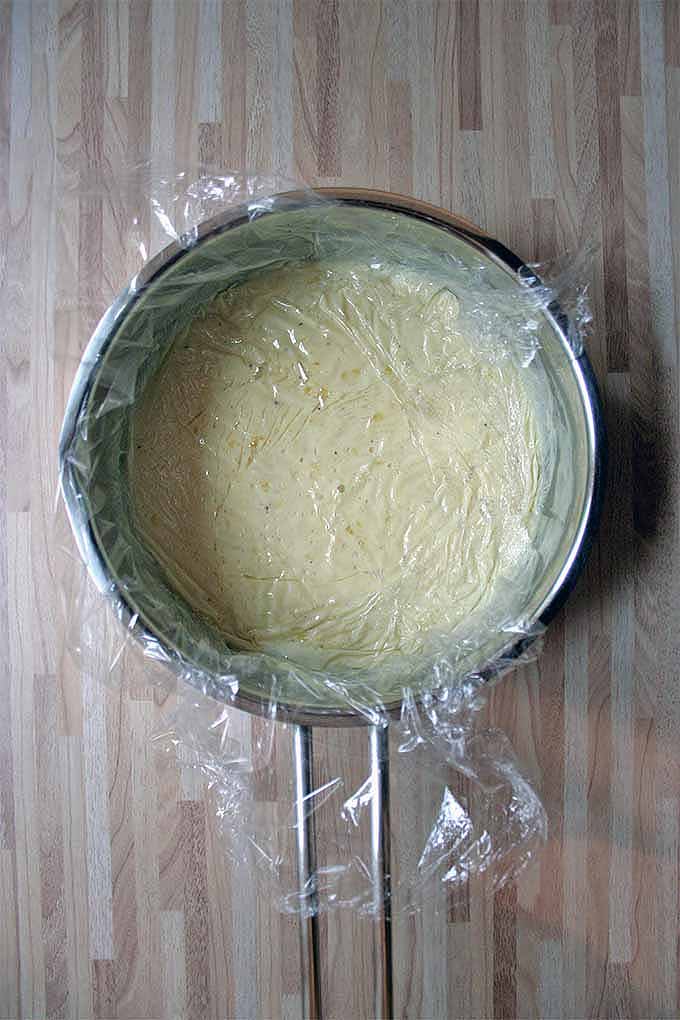
If you’re making the pudding, cover it with plastic wrap to keep a skin from forming, and chill thoroughly in the fridge.
Is vanilla too… meh? Switch to a homemade chocolate pudding for a richer, more luxurious taste!
Step 2 – Dissolve Yeast
In a small bowl, dissolve the fresh yeast in the milk. Use cold, full-fat milk.
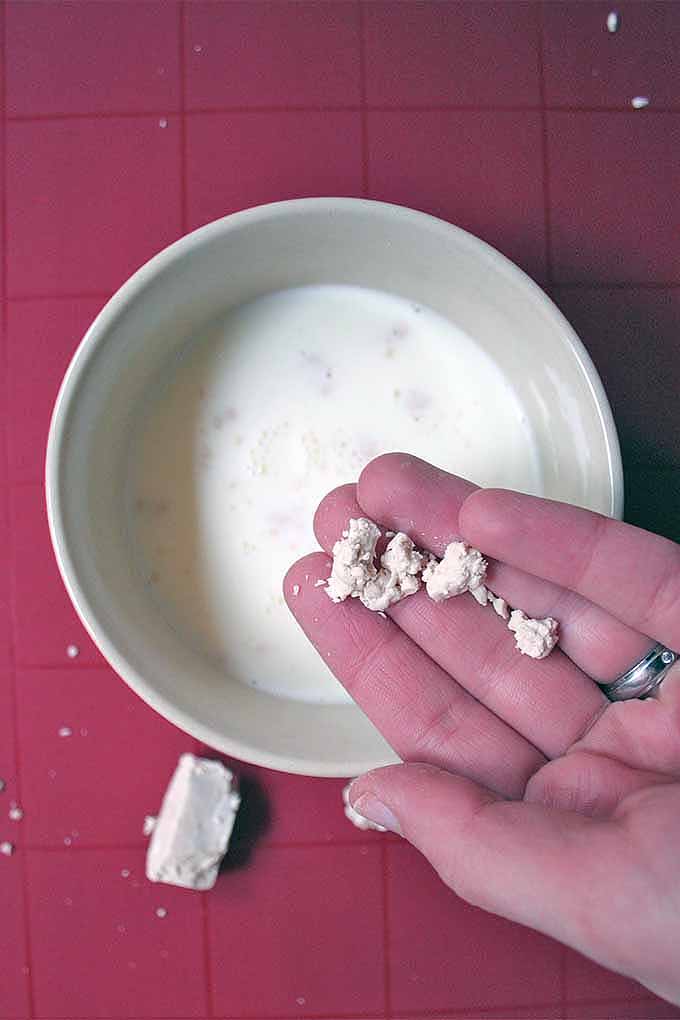
For suggestions on yeast substitutions if the fresh kind is not available, check out the handy chart in Kendall Vanderslice’s article on baking with yeast. Other types of yeast may react differently when combined with cold milk, so alterations are not recommended.
Step 3 – Combine Ingredients
Pile the flour into a little hill in a large bowl or on a floured countertop, and create a well in the center.
Add the sugar, egg, and the yeast-milk mixture, to the well, and combine, beginning by moving a little flour into the well from the edges and continuing to mix until all of the flour is thoroughly incorporated.
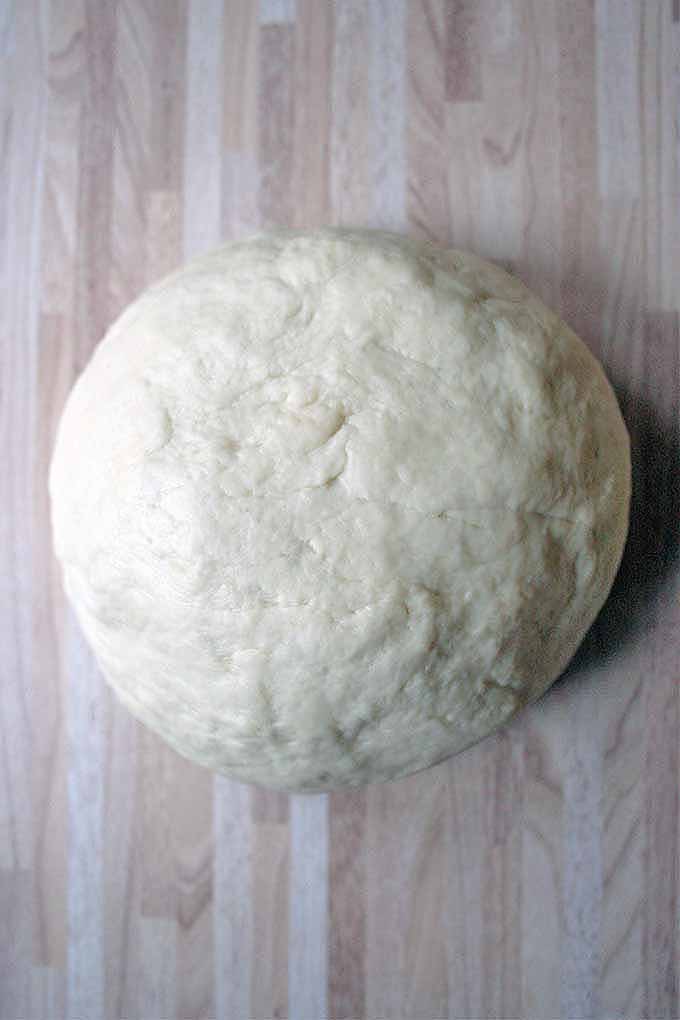
Knead everything together until a smooth dough is formed.
Step 4 – Roll and Spread
On a floured countertop, roll out the dough into a large rectangle, about 17×13 inches and 0.2 inches (5 millimeters) thick.
Leave border of about 1 inch around the perimeter, and spread the softened butter on the right 2/3 of the dough. Leave 1/3 of the surface unbuttered on the left side.
Step 5 – Fold and Chill
Fold the unbuttered part on the left into the middle. Then fold the right side into the middle, overlapping with the folded left portion.
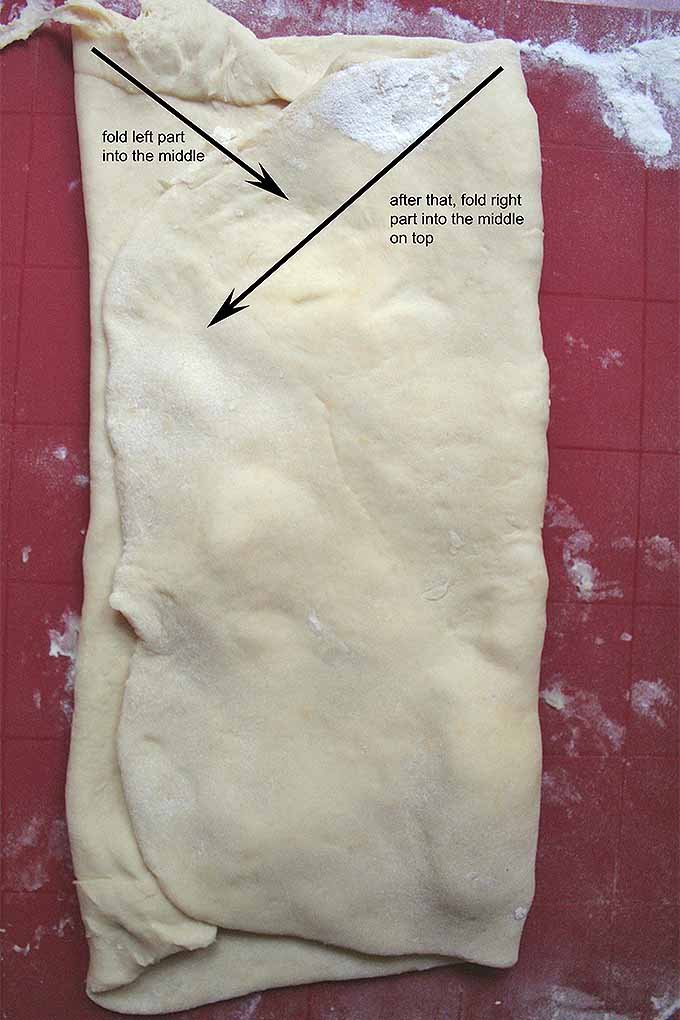
Wrap carefully in plastic, and place in the fridge to chill for 30 minutes.
Step 6 – Laminating
Take the chilled dough out of the fridge and return it to your floured countertop. Continue to perform the laminating procedure, creating more layers that will result in a flaky, light and airy dough.
To do this, repeat procedure in steps 4 and 5. Roll the dough out into a large rectangle, fold in the left side, and fold the right side in to overlap on top of that.
Complete this procedure again (this will be your third time). Again: roll out a large rectangle, fold the left, and fold the right side over it.
Step 7 – Roll and Cut
Roll out into a large rectangle about 0.2 inches thick, and cut into 15-18 strips of equal width with a sharp knife or a pastry wheel.

Step 8 – Twist into Pretzels
Roll each strip into a long rope beneath your palm on a floured countertop. Then twist each into a pretzel shape.
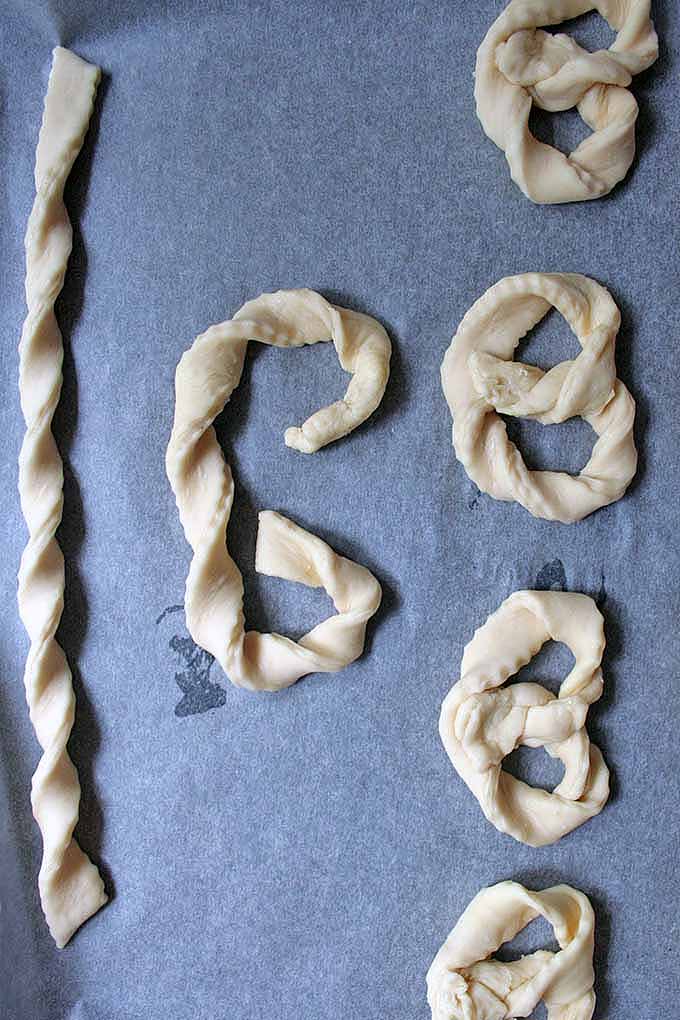
Place on baking sheets lined with parchment paper, with about an inch in between so they won’t slick together when they bake.
Step 9 – Fill
Fill a pastry bag with a star nozzle attachment with your pudding and pipe into the holes of each pretzel. Leave to rest on the countertop for 30 minutes.
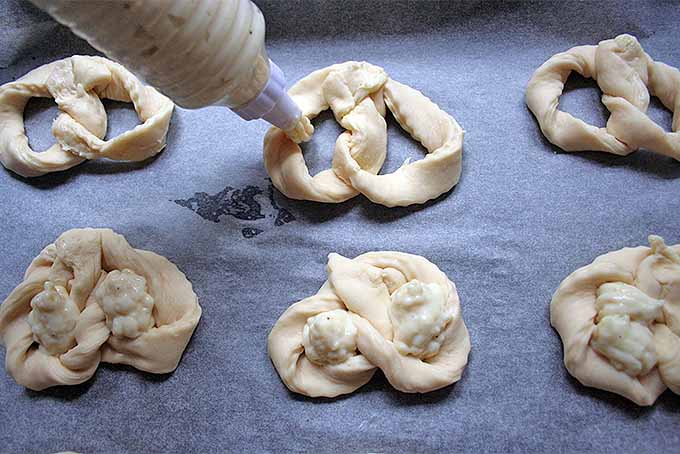
Meanwhile, preheat the oven to 400°F (220°C).
Step 10 – Bake
Bake for about 15 minutes until lightly golden.
Take the danish out of the oven and leave to cool for at least 30 minutes on the parchment paper.
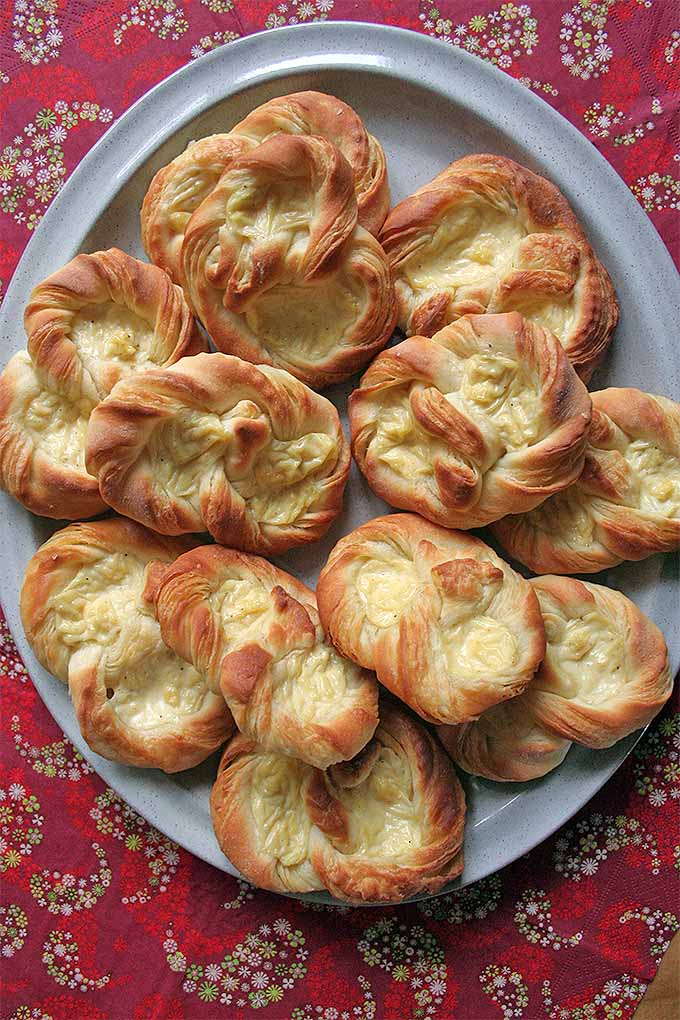
It’s important not to lift them while they’re still hot, because the warm pudding can easily stick to the paper and you’ll have a big mess on your hands.
Gently transfer from the sheet using a metal spatula, and enjoy!
Delicious by Any Name
So, let’s summarize: We have an Austrian pastry that was adapted by the Danes, which was then used to make this popular German delicacy. And now, you’re able to make it at home wherever you are.
If this isn’t intercultural – or better “interculinary” knowledge, I don’t know what is!
Whatever you call the method or the final food product, the German puddingbrezel makes a delicious addition to breakfast, afternoon tea, or Oktoberfest food spread. If you enjoyed these delights, then you may like our buttery fruit-filled donut recipe as well.
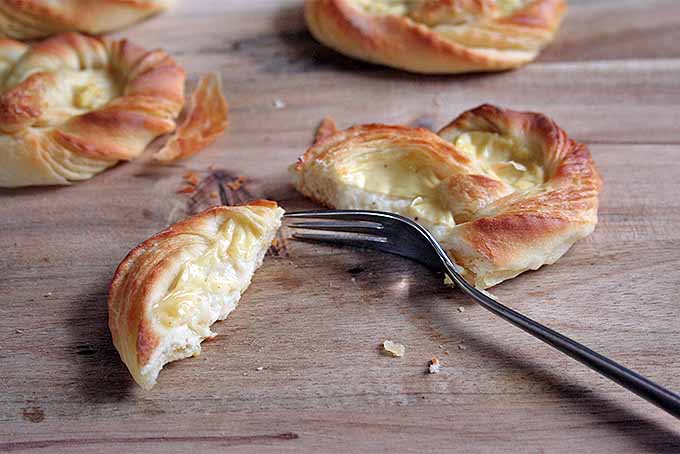
Make your own at home, and use the hashtag #EatFoodal on Instagram to share your creations with us!
Looking for more German desserts? Try my recipe for cute and pretty Amerikaner cookies cakes!
What shapes will you make, and what will you use to fill your pastry? Let us know in the comments.
Photos by Nina-Kristin Isensee, © Ask the Experts, LLC. ALL RIGHTS RESERVED. See our TOS for more details. Originally published November 4th, 2016. Lasted updated September 13th, 2020.
About Nina-Kristin Isensee
Nina lives in Iserlohn, Germany and holds an MA in Art History (Medieval and Renaissance Studies). She is currently working as a freelance writer in various fields. She enjoys travel, photography, cooking, and baking. Nina tries to cook from scratch every day when she has the time and enjoys trying out new spices and ingredients, as well as surprising her family with new cake creations.


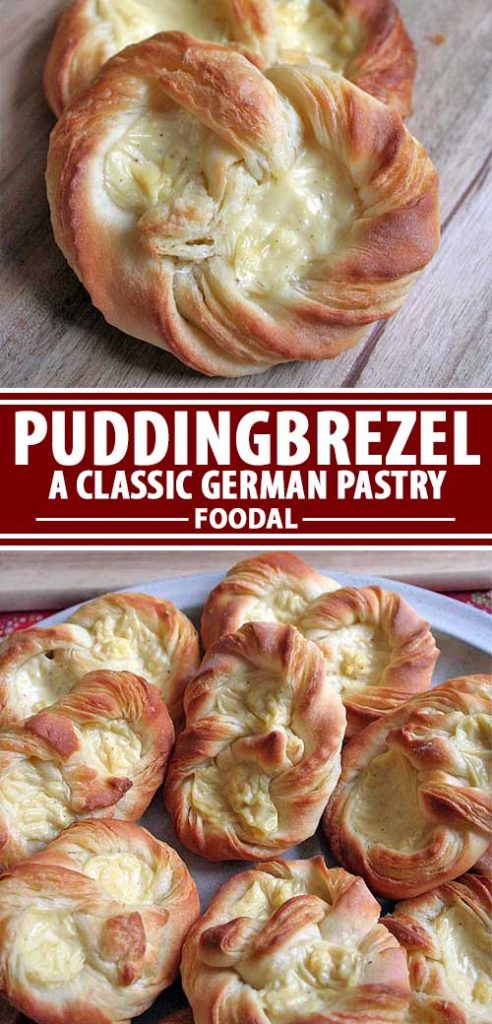
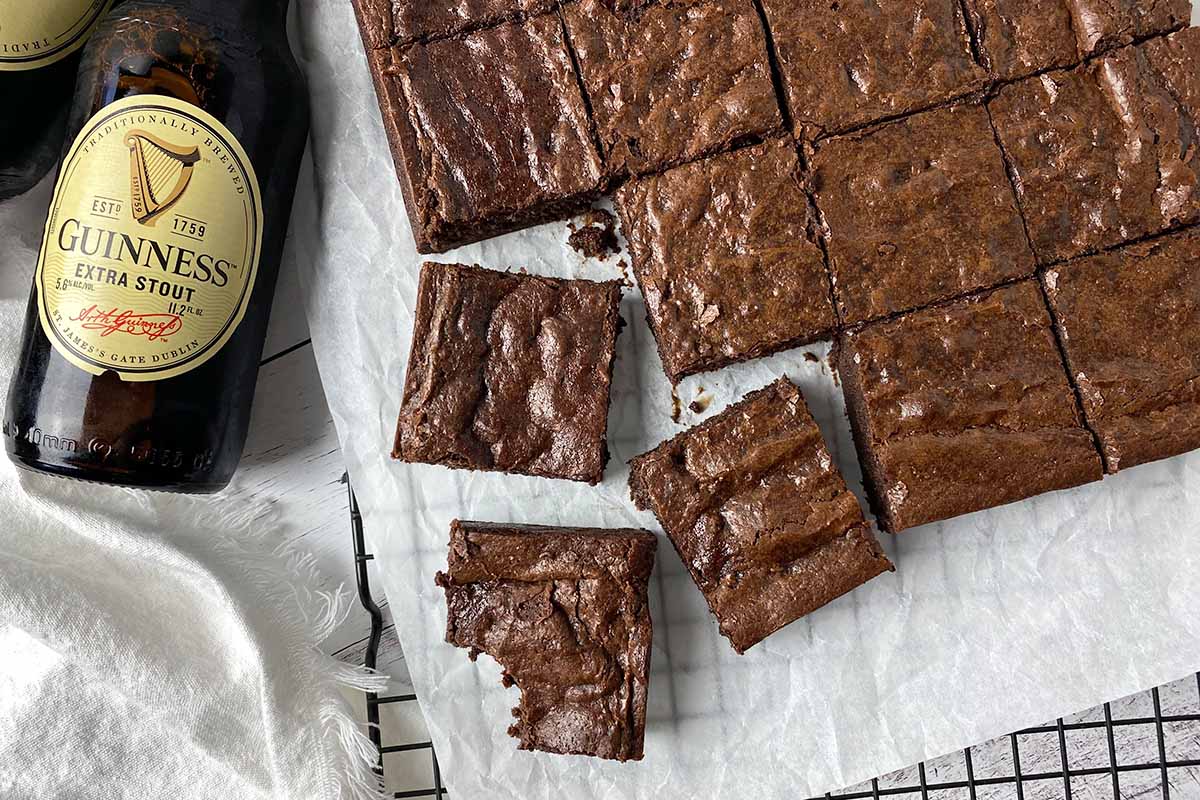
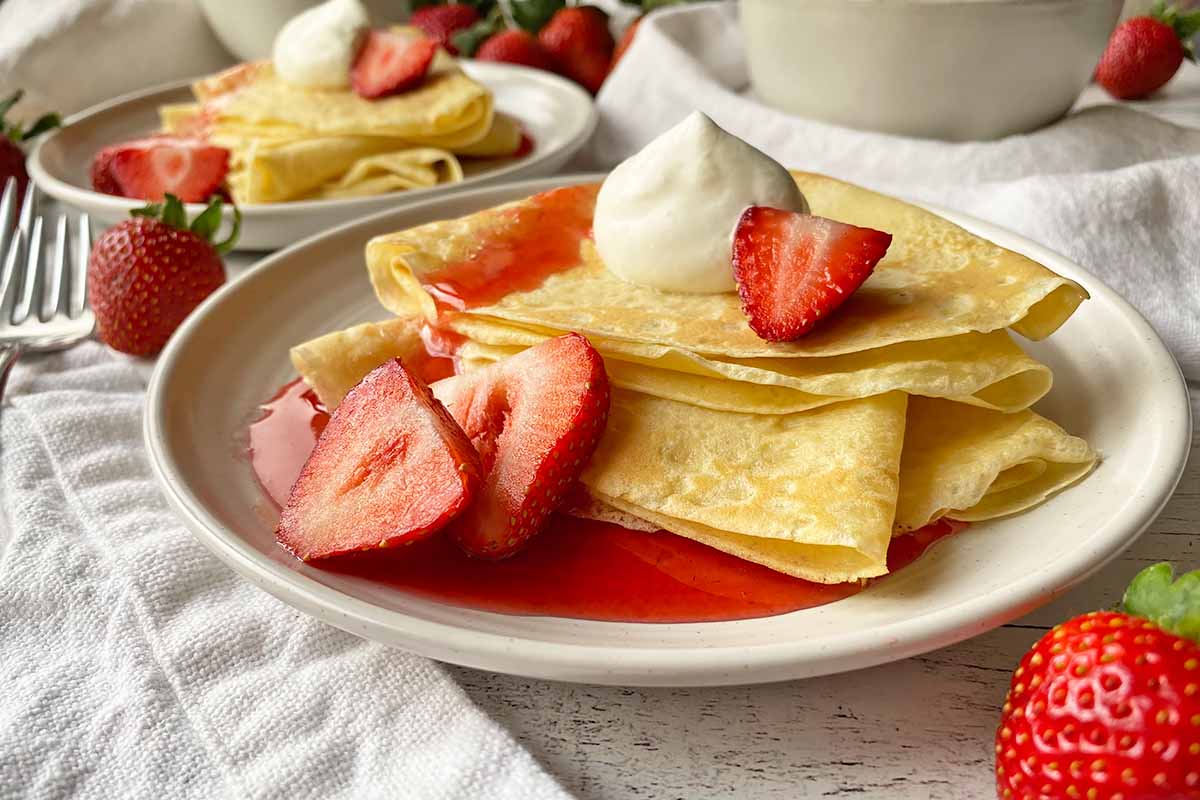

Roll out the dough 2 inches thick? Are you kidding me?
I believe it was .2 inches thick. 🙂
Why is there an asterick next to egg? Is the egg optional?
No KJ, I believe that’s a formatting error on our old recipe plugin. We’ve switched to a new one and this recipe is on our list for an update- please ignore the asterisk!
I remember having these for a quick breakfast or snack while traveling the German countryside about 20 years ago. Puddingbrezels are amazing. So gooey and delicious and surprisingly portable from what I remember, so they are great to take on the go. I love Germany and the people! My great-great-grandparents came from the Alsace-Lorraine and possibly Bavarian area from what I remember my grandparents saying. Servus!
I’m so glad I found this recipe. I haven’t had these since I was stationed in Germany. Made a batch. Taste like I remember them.
★★★★★
What is the best way to store these?
Hi, Kaylee! The best method for storing pastries like this is in an airtight container at room temperature for up to three days – homemade pastries are best enjoyed as fresh as possible! Though refrigeration tends to negatively alter the texture of laminated doughs, you can definitely freeze them. Place them in an airtight container, with parchment paper in between each layer to prevent sticking. Thaw at room temperature.
Really delicious but the dough could use some salt. I brushed the top with 1 egg and vanilla before baking. II finished with some icing drizzle and almonds. Will make again but I’ll add some salt the next time ☺️
★★★★
Awesome to find a recipe for a well known Puddingteilchen I grew up with. I have been making a similar recipe for years. Mine has powder sugar in the dough for added sweetness. Thank you for sharing it, sadly here in the US the pastries are less tasty, at least here in Florida.
It is funny to suggest chocolate pudding, you’re right I have also never seen one in any different flavor than vanilla.
Aber jetzt moechte ich doch noch mal fragen wo denn das Wort Plunder herkommt, das habe ich noch nie gehoert um einen Teig zu beschreiben. Ich bin aus Koeln und Plunder schmeissen wir auf den Muell, lol.
Thank you for sharing this great traditional recipe.
Thanks for your message, Kristina. Hope you enjoy the recipe!
You might also hear this referred to as “Plunderteig” in some places, though it does seem to be a more old-fashioned term.
Boy, was I excited when I saw this! I’ve visited Germany several times in the past, and in the little town we stayed at (Unterheinreit), there was a bakery within walking distance from our home. Every morning, I’d walk there to get my puddingbretzel. I was addicted to them! I cannot wait to give this recipe a try! I’ll put icing on them, because that’s how the little bakery made them. Thank you for sharing this recipe!
I haven’t tried this yet, but it occurs to me that it might be good with some almond pastry cream in the middle, too. You make the laminated dough sound so easy!
I was in a drama/music ministry many years ago and I spent a lot of time in Germany. Our headquarters was in a small town called Unterheinriet, and they had a small bakery there. That was the first time I ever had Puddingbretzel and I fell in love. I had it as often as I could. When I came back to Germany a few years later, the little bakery had stopped selling it. I was so sad. It’s been almost 40 years since then and imagine my surprise and thrill at finding your recipe. I’ve made it twice now and it’s so delicious. It just takes me back to those days. Thank you so much for sharing your recipe. It’s now a cherished recipe that makes me so happy.
★★★★★
Thanks for sharing, Christina! Enjoy!